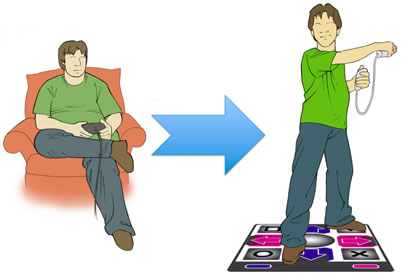

The Research

The game is being developed as part of a research project currently in progress in the Games for Entertainment and Learning Lab at Michigan State University and partially funded by the Robert Wood Johnson Foundation through the Health Games Research initiative. The research is led by MSU Professors Wei Peng, Brian Winn, and Karin Pfeiffer.
Youth become increasingly less active as grade in school increases, with the most dramatic declines occurring during adolescence and young adulthood (Caspersen, Pereira, & Curran, 2000; Leslie, Sparling, & Owen, 2001). As the transition from adolescence to early adulthood is a critical period that may contribute to adult habits and health-related behaviors (Baranowski et al., 1997), it is crucial to start physical activity promotion effort in this age group to address the health problems that may occur later in adulthood. Overweight college students who do not have adequate physical activity are chosen as the target population of this study.
One of the most significant contributors to sedentary lifestyle is screen time, the amount of time spent in front of the television or computer monitor (Robinson & Borzekowski, 2006). Once considered as a sedentary medium that contributes to sedentary lifestyle and obesity (Van dewater, Shim, & Caplovitz, 2004), video games (e.g., Dance Dance Revolution, Play Station 2 EyeToy Kinetics, and Wii Fit) that require actual human body movements for interaction with the game interface are increasingly being used to promote physical activity (McDougall & Duncan, 2008; Ridley & Olds, 2001; Tan, Aziz, Chua, & Teh, 2002; Unnithan, Houser, & Fernhall, 2006). Although promising evidence is available to support the use of these video games which are called exergames for physical activity promotion, all of these studies employed only simple comparison of treatment and control groups. Few studies adopted a theory-based approach to understand how these exergames work to promote physical activity. In addition, as it is not feasible to modify commercial-off-the-shelf games, researchers are also limited in their endeavors to manipulate features of these games to examine which features work better to promote physical activity.
One theoretical approach to human motivation that is receiving increasing attention in the exercise domain is the self-determination theory (SDT; Deci & Ryan, 1985; Ryan & Deci, 2000). According to SDT, the reasons why individuals choose to participate, exert effort, and persist in an activity can be categorized along a continuum of self-determined regulation. The most self-determined form of behavioral regulation is intrinsic motivation, which is defined as engaging in an activity for the pleasure and satisfaction derived from the activity itself. One the opposite end of the continuum is amotivation, that is, lack of motivation or intention. Situated between is extrinsic motivation, which refers to behaviors that have carried out to attain outcomes unrelated to the activity itself.
SDT also assumes that all humans possess three basic psychological needs: the needs for competence, autonomy, and relatedness (Deci & Ryan, 1985). Specifically, the need for competence implies that individuals have a desire to interact effectively with the environment, to experience a sense of competence in producing desired outcomes, and to prevent undesired events. When individuals satisfy their needs for competence and have perceived competency, the status is then very similar to the feeling of self-efficacy as described in Social Cognitive Theory (Bandura, 1997). The need for autonomy reflects a desire to engage in activities of one's choice and to be the origin of one's own behavior. Finally, the need for relatedness involves feeling connected, or feeling that one belongs in a given social milieu. The context of a given activity can influence how the basic psychological needs can be satisfied (Ryan & Deci, 2000). Competency, autonomy, and relatedness supportive contexts are conductive to need satisfaction and ensuing self-determined motivational regulations. For instance, competence-supportive contexts can be established by providing positive feedback, developing appropriate goals, offering opportunities for practicing skills, affirming small steps as they were taken, and reinforcing positive change (Silva et al., 2008). Autonomy-supportive contexts are characterized by the minimization of controls by others, the provision of choices that guide and facilitate the decision-making process (Silva et al., 2008). Relatedness-supportive contexts are enabled by including significant others in the activity (Wilson et al., 2006).
Therefore, the purpose of this study is to incorporate the self-determination theory (Ryan & Deci, 2000), a widely used human motivation theory in the exercise domain, to the design of exergames as well as to empirically test designing principles for exergames. For the hardware portion, we will repurpose the dancepad used for Dance Dance Revolution and the Wii remote and nunchuk as the input devices for our exergames to enable human movement-based interaction with the game interface.
The unique contribution of the study includes five parts. First, existing hardware and technology used in commercial-off-the-shelf exergames (i.e., dancepad, Wii remote, nunchuk) will be innovatively adopted and converted as input devices for users to interact with PC-based games. Testing of this concept will provide evidence for commercial game developers to consider supporting these "active" input devices besides the traditional "passive" controller in their games so that more games available on the market can be played actively using actual human movements. Second, Olympus is about "stealth exercise". The player is so engaged in the experience of the game, they do not realize they are burning calories and getting an effective workout. Third, based on the self-determination theory, this study will advance our understanding of the game play experience and prescribe guidelines to design exergames more effectively by examining how the game features increase competence, autonomy, and relatedness which are the three main components of motivation. We will also investigate how these three components mediate the relationship of playing exergames and the dependent variables. Fourth, both short-term and long-term effectiveness of the exergame will be studied. A lab experiment will be conducted to test what game features work better to motivate players psychologically and have actual physiological outcomes (i.e., greater energy expenditure). Afterwhich, a 12-week study will compare the exergame-based intervention with a a more traditional passive version of the game to provide evidence for the long-term effectiveness of the exergame. The outcome measures include both self-reported psychological variables as well as objective measures of energy expenditure and weight loss.






